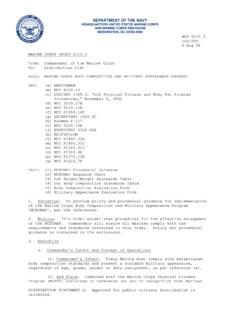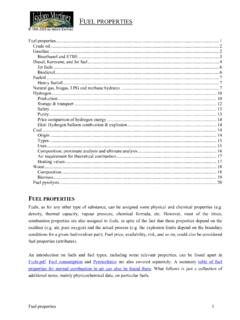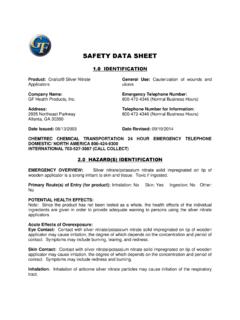Transcription of This document has been conceived as a guidance document …
1 1. TECHNICAL GUIDELINES1. SANTE/11956/2016 rev. 9. 14 September 2018. Technical guidelines for determining the magnitude of pesticide residues in honey and setting Maximum Residue Levels in honey Implemented by 1 January 2020. 1. This document has been conceived as a guidance document of the Commission Services. It does not represent the official position of the Commission. It does not intend to produce legally binding effects. Only the European Court of Justice has jurisdiction to give preliminary rulings concerning the validity and interpretation of acts of the institutions of the EU pursuant to Article 267 of the Treaty.
2 2. 1 Introduction .. 3. 2 Residue definition for honey and bee products .. 6. 3 Decision-making 6. Are residues expected in honey after pesticide application? .. 6. What is the residue level in aerial parts of the crop? .. 7. Experimental studies via syrup feeding .. 8. Experimental field or tunnel data .. 8. Is the active substance included in a veterinary medicinal product? .. 8. 4 monitoring data .. 9. 5 References .. 10. APPENDIX I : Decision making scheme for MRL setting in 12. APPENDIX II : List of melliferous crops .. 13. APPENDIX III : Experimental studies via syrup feeding.
3 30. APPENDIX IV : Field residue trials for MRL setting in honey .. 34. APPENDIX V : Tunnel residue trials for MRL setting in honey .. 38. 3. 1 INTRODUCTION. Honey can potentially contain residues of plant protection products (PPPs) since honeybees may be exposed to such products either directly or indirectly by collection of nectar and pollen. Residues of plant protection products are sometimes found in honey during residue monitoring and levels can vary from one substance to another. It is therefore appropriate to establish safe Maximum Residue Limits (MRLs) for consumers. Since a methodology on the data needed and the approach for using them to set appropriate MRLs is not available, the MRLs for honey have historically been set at a default level of mg/kg.
4 European data requirements (Regulation (EU) No 283/2013, Annex ) require studies on residues in pollen and bee products for human consumption, but do not specify the type and conditions of the studies to be performed. According to the Regulation, type and conditions shall be discussed with national competent authorities. These Technical Guidelines will fill this gap and give further technical information on studies and data required, enabling EFSA. and the Commission to refine MRLs for honey in the interest of consumer protection. These technical guidelines have been endorsed by the Standing Committee meeting of 18-19 September 2018.
5 MRLs for honey are also reflected in Article 16(c) and Annex I (part A and B) of Regulation (EC) No 396/2005. where the possibility to set temporary MRLs is given. Honey has been considered as a food of animal origin (cf Annex I of Regulation 396/2005: code 1040000, under PRODUCTS OF ANIMAL ORIGIN -TERRESTRIAL ANIMALS). As a general rule, pesticides may be ingested or absorbed by livestock in three ways: 1. following direct application of the product to the animal, 2. as a result of treatment of their accommodation, 3. through residues in feeding stuffs. Residues of pesticides arising from uses as veterinary medicinal products or after accommodation (beehive).
6 Treatment (cases 1 and 2) must be taken into consideration when setting MRLs for plant protection products. In the first two cases MRLs have been set in the past by Council Regulation (EEC) No 2377/90 (now replaced by Regulation (EU) No 37/2010). In case 3, pesticide residues may arise in honey from current pesticide uses. MRLs established in this case should in principle be set on the basis of appropriate supervised residue trials data. The situation for honey is not comparable to other situations where supervised trials are carried out as residues may be taken up by the honeybees during collection of nectar and/or pollen when plant protection products are used while the treated crops or adjacent non-target plants are flowering or during collection of nectar and/or pollen from flowering rotational crops after the use of persistent systemic products.
7 As estimated from the data available in the EFSA Model for risk assessment of pesticides MRLs (PRIMo: Pesticide Residue Intake Model), the average consumption of honey per capita and per day in Europe is less than 5 g/capita/day and thus represents a very small part of the total diet. This would consequently not imply a significant contribution to the Theoretical Maximum Daily Intake (TMDI), usually calculated in order to assess the chronic risk of dietary exposure. Considering the acute exposure, according to: - the EFSA Model PRIMo ( ): - critical Large Portion of and g/kg bw respectively defined for adults (CZ males 15-17y) and children (NL toddler), - case 1 equation (International Estimate Short Term Intake (IESTI) = LP x HR / ARfD), - an Acute Reference Dose (ARfD) of x 10-4 mg/kg bw/day, which corresponds to the lowest ARfD.
8 Established to date (for carbofuran), a maximum level of honey contamination can be set at mg/kg. This calculation shows that any MRL, even the default value of mg/kg further proposed, should be checked for acute risk of dietary exposure, using PRIMo. The Limit Of Quantification (LOQ) needs to be set at a lower level in case a risk for consumers is identified at the default level of mg/kg. Honey, wax, pollen loads, drone larvae, propolis and royal jelly can be harvested from beehives. 4. Honey, honeycomb, pollen, royal jelly, wax and propolis have been considered most pertinent for consumers.
9 The composition of these products is described in literature. For the purpose of this exercise the content of water, lipids and sugars is important, The following table lists values from literature2, 3, 4, 5. Bee products composition Water content Lipid content Carbohydrate content Honey(a) 16 - 22% -- 70 - 80%. Nectar(a) 40 50% 5 80%. Wax(e) (f) -- 64%-67% fatty acid -- esters, 12-15% fatty acids, 1% free alcohols Pollen (air dried)(g) 7 - 11% 5% 32 37% (hand- collected 19%). Propolis(h) (i) 25 - 50% (waxes and Less than 5% (and 5%. fatty acids) pollen). Royal jelly(k) (l) 57 - 70% 3,5 - 19% of dry weight 18 52% of dry weight Bee wax, honeycomb, pollen and raw propolis as well as royal jelly contain lipids in different amounts (all above 5%).
10 Due to the lipid content of these matrices, it is expected that fat-soluble active substances will be found at higher levels than in honey. In addition, available monitoring data indicate that for the same substance pollen contains higher residues compared to honey. Bee wax is used in cosmetics and pharmaceuticals for production of lip balm, lip gloss, hand creams, salves, and moisturizers, eye shadow, blush, and eye liner. In food industry, bee wax is used for cheese coatings and as food additive E901. In addition beekeepers recycle bee wax. They remove old brown combs at the end of breeding period for hygienic reasons.


















